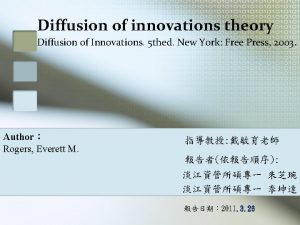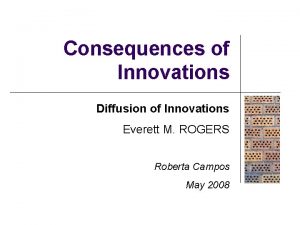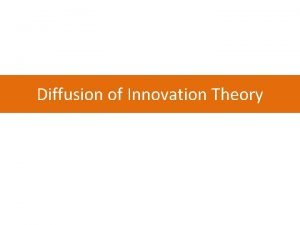Diffusion of innovations January 27 2016 Diffusion of





- Slides: 5

Diffusion of innovations January 27, 2016

Diffusion of Innovations Rogers, E. M. (2003). Diffusion of innovations (5 th edition). New York, NY: Free Press q 5 qualities for innovations’ spread - Relative advantage (economic advantage, prestige, convenience, etc. ) - Compatibility with values, practices, etc. Simplicity & ease of use Trialability Observability (visible results) 2

Diffusion of Innovations (cont. ) Rogers, E. M. (2003). Diffusion of innovations (5 th edition). New York, NY: Free Press q P 2 P conversations & peer networks - Impersonal MKT (advertising, media stories, etc. ) may spread info about innovations - But majority of people are risk-adverse (financial loss, waste of time, mental stress, etc. ) - Adoption by majority depends on personal accounts by early adopters - P 2 P conversations with early adopters creates peer networks that help the spread 3

Innovation adoption process Five stages of the adoption process Stage Knowledge Persuasion Definition In this stage the individual is first exposed to an innovation, but lacks information about the innovation. During this stage the individual has not yet been inspired to find out more information about the innovation. In this stage the individual is interested in the innovation and actively seeks related information/detail. Decision In this stage the individual takes the concept of the change and weighs the advantages/disadvantages of using the innovation and decides whether to adopt or reject the innovation. Due to the individualistic nature of this stage, Rogers notes that it is the most difficult stage on which to acquire empirical evidence. Implementation In this stage the individual employs the innovation to a varying degree depending on the situation. During this stage the individual also determines the usefulness of the innovation and may search for further information about it. Confirmation In this stage the individual finalizes his/her decision to continue using the innovation. This stage is both intrapersonal and interpersonal, confirmation the group has made the right decision. 4

Adopters segments q Innovations’ adopters can be broken into 5 segments Adopter category Definition First individuals to adopt an innovation. Innovators are willing to take risks, often have great financial liquidity, Innovators and have closest contact to scientific sources and interaction with other innovators. Risk tolerance has them adopting technologies which may ultimately fail. This group appreciates and recognize the value brought on by new ideas and technologies and are willing to Early adopters suffer an inconvenience of failing. They are not idea generators but rely on intuition to make decisions. They trust their gut. This group is more practically minded although slightly comfortable with new ideas and technologies. Early Majority However, they will not try a new product until someone has tried it first. This group is also practically minded. Practical factors matter more and will not try something until someone Late Majority else has tried it first. This group usually only accepts new technologies or ideas because they have no other options. These are the Laggards people who are using touch-phones because rotary phones are no longer available. Laggards typically tend to be focused on "traditions“. 5









